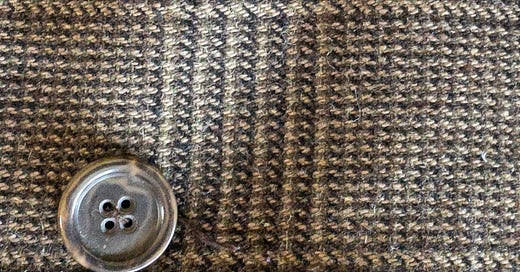The “Collection of One” series is sometimes about navigating clothing archetypes1 and reflecting on how to choose and keep pieces that perform their role particularly well.
In this installment, there’s a bit of cheating going on here. I would never claim to own only one piece of outerwear (or even just one peacoat). Instead, I wanted to look back at the epiphanic revelation of my first good piece of outerwear (double breasted peacoat) and give some account for how that moment of self-realization has played out.
If you want a history of peacoats, there’s plenty of other writers who have covered it better. We also all know about the functions of outerwear, so here we want to look at the inner meanings—we’re after Weltanschauung, not warmth.
//
Hints of a Wider World
We are time traveling back to when physical retail was primary. The clothes you wore in the mid to late 2000’s were usually purchased from a real place, often after physically trying them on in a fitting room (a locking stall with mirrors upon which well meaning sales associates would knock and ask “how’s it going in there?”).
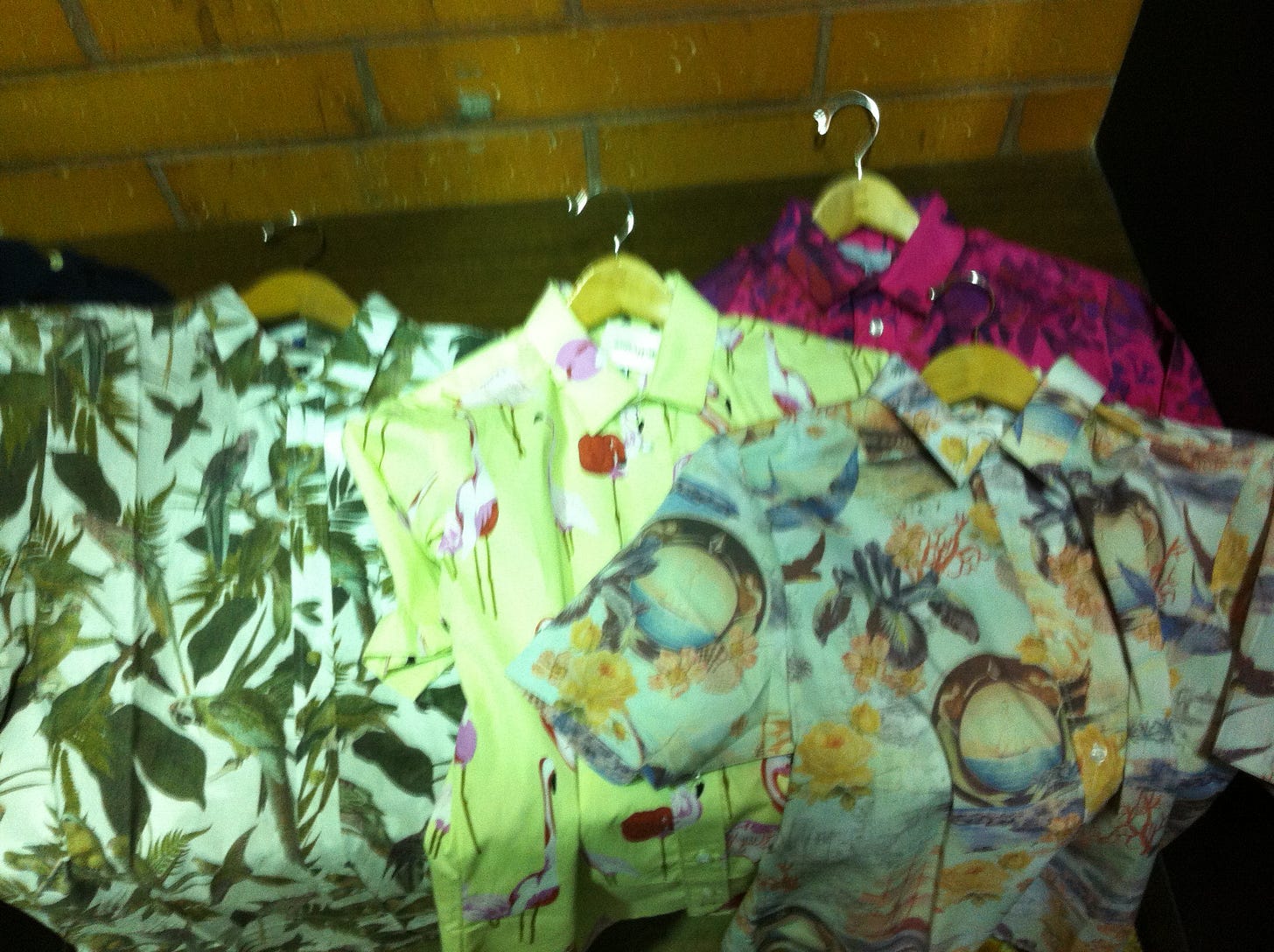
The local availability of certain stores/styles and their seasonal offerings dictated what you could wear, and even what you could discover. In my suburban hometown, most physical retail was at the mall, and Banana Republic was the only modest gateway available to experiencing menswear concepts that went beyond skate clothes and business suits (otherwise you could only glimpse the existence of such items in the realer/wider world through copies of GQ and Esquire2).
In 2007, I was in this Banana Republic when I saw a jacket on the sale rack.3 I didn’t know it at the time, but I was looking at a wool double breasted peacoat in glen plaid.4 My initial interest stemmed from the fact it was discounted and looked sort of military/surplus-y (I didn’t understand what I was looking at, and now it’s much easier to understand the connections between frock coats, greatcoats, redingotes in the style of Napoleon, etc. and how they manifest themselves in today’s outerwear). There was also only one of these jackets in the store—it had landed from outside that place and time like one of Clarke’s Monoliths.
I tried it on (in the fitting room of course) and it was, to my eye, beautiful in its fit, details and finish. I remember the feeling of putting that jacket on with perfect clarity. The moment it landed in place on my shoulders I felt like a different person. That coat presented new possibilities and the hints of a wider world. This transformational piece of outerwear was a gateway drug in retrospect—that initial high of finding and acquiring such an unexpected item would subsequently drive a lot of additional purchases (and mistakes), but more importantly, lead to greater self-discoveries.
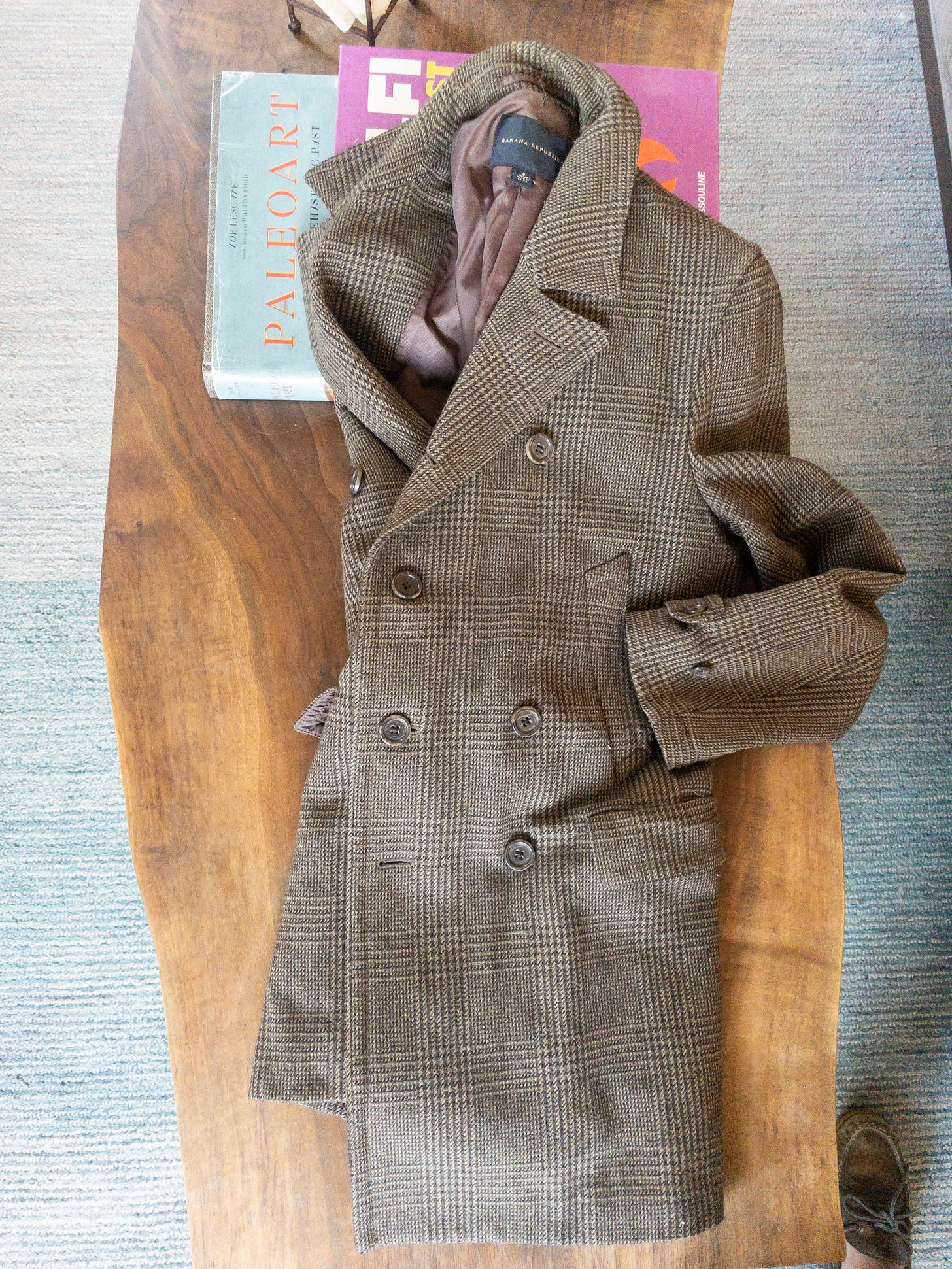
This ‘Made in China’ mall brand peacoat demanded that I ask, “what other transformative stuff is out there that I know nothing about?” Internet commerce has nearly eliminated this feeling of serendipity/discovery (of just wandering into a place and seeing what is in stock), but the experience is narrowly holding on as the importance of physical retail and curating a sense of place and space experiences a small rebound (our glass rectangles seem to leave us all wanting a sense of the tangible).
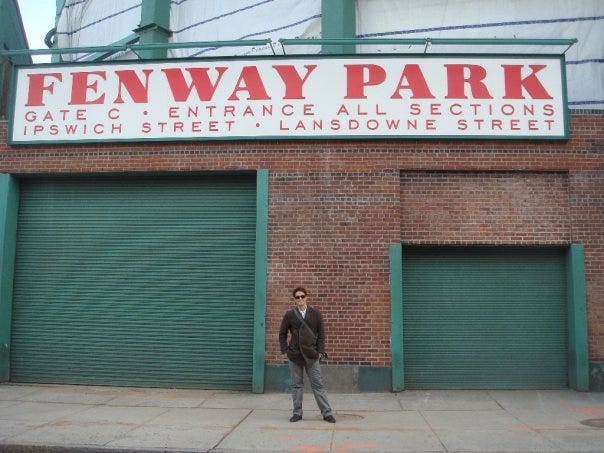
Assembling the Catalogue
Fast forward 17 years and I now have an embarrassment of outerwear. In evolutionary terms, it’s been a Cambrian Explosion of coats and jackets for all occasions. The knowledge of the life changing aspects of good outerwear has landed me here. But where is that and is it any good?
As an exercise in disclosure, I’ve done the uncomfortable task of cataloging my outwear. It’s important to gaze unflinchingly into what is (or as Werner Herzog would have it, “the poet must not avert his eyes”).
For those who don’t like reading lists or the neurotic justifications of a collector, you just need to know I own 23 jackets, vests and other pieces of outerwear and you can scroll down to the image gallery of the peacoat to pick up the narrative from there.
With much fanfare, I am pleased to present the Sublime Prosaic Embarrassment of Outerwear Archive:
1 Ventile Mac (a proper noun) rain coat (royal blue, a collaboration between PVT White and Garbstore; owning this in Los Angeles would have been insanity and only for travel to fogged-in places were it not for the last few years of locally increased rainfall);
1 suede blouson (The Wright Jacket from The Armoury, my favorite jacket to wear when I am not parenting anyone);
1 French blue chore jacket (by Le Mont San Michel, in cotton moleskin with corozo buttons and a real pleasure to wear for actual chores);
1 windbreaker (a newer piece from Michael Bastian’s version of Brooks Brothers, has contrasting trim, a zip out hood and was purchased to replace my Musto Sailing Jacket, which is disintegrating; school drop off appropriate on spring and summer mornings as well);
1 sailing jacket (in white and made by Musto for West Marine around 2013; it’s falling apart and is probably one of the pieces closest to leaving my closet, but still has sentimental value/marginal utility);
1 sailing vest (also by Musto because I’m a contrarian at heart and refuse to buy Gill, Helly Hansen or any of the other brands worn by the actual/competent sailors I know);
1 layering vest (Brunello Cucinelli via eBay, reversible from brown linen to navy cotton - a beautiful and very versatile piece, can see as much wear in the summer as it does in the colder months);
1 Lululemon cycling jacket (made for cycle commuting, has reflective details and oversized chest pockets; I love this jacket but it’s mostly kept for when I need a work out jacket, also functions as a good overshirt);
2 tebas (both City Hunter models from The Armoury, one linen, one wool, both navy, great for flying, cycling and for casual days in the office);
1 leather jacket (in black and by Theory, a gift and essentially only ever worn in New York; primarily retained for sentimental value and because prior to buying my suede jacket this was filling in the category/need for an upscale casual jacket);
1 sherpa collar corduroy trucker jacket (a white corduroy number from OuterKnown via eBay, replacing/replicating a similar one by French Connection I had in my late teens/early 20s that I had acquired from a thrift store);
2 linen safari jackets (both by Ascot Chang for The Armoury, one brown, one navy, essential for flying, business trips, cigar sessions and everything else; both replacing a white version I had from Banana Republic I had in my early 20s, another life changing piece of outerwear that will get its own write up when the weather merits it);
1 double breasted cotton peacoat (a beautiful piece from Tom Ford in a midnight navy, has a lot of drama with a belted back and a rear gusset, leather trimmed pockets, etc., also acquired from eBay and in a light enough fabric that it can be worn most evenings/on a year round basis);
1 polo coat (80s vintage, in camel hair by Brooks Brothers from eBay, an amazing find that is full length and hits mid-calf, includes belted back, double breasted closure and seamed sleeves);
1 snorkel parka (from A&F’s super parka line, purchased years ago for an Iceland trip—this one could use an upgrade, but for now I’ve come to my senses about how often I actually need a parka and this one works fine);
1 ski jacket (by Patagonia, for heavy snow activities, not that I’ve gone skiing for many years, but could be changing with kids coming up to ski school age; was actually purchased for tubing with colleagues);
1 Chesterfield/wool double breasted car coat with fur (?) lined collar (an amazing jacket from my father’s own New York phase, this comes out whenever it’s cold enough and has served a few tours of duty on New Years Eve and at Sundance);
1 Filson waterfowl hunting jacket (if I’m going to hunt ducks once a year, I wanted it to be in Filson);
1 LL Bean Field Jacket (purchased many years ago and I like it, but is being kept on hand for archive purposes; I suppose it could be used for chores in the mountains or upland hunting, but I don’t have immediate plans for either);
1 double breasted wool glen plaid peacoat (from Banana Republic as discussed above, must distressed and retained for sentimental and archival purposes alike); and
1 Barbour quilted jacket (their Lutz model in navy, a newer purchase driven by wanting something less cumbersome to wear in cold weather when a full length or car coat is not desired; I’ve been grabbing this one a lot this winter, so cost per wear and other considerations are tracking nicely).
[and a partridge in a pear tree]
What am I doing with all of this outerwear? To illustrate how unreasonable 23 pieces of outerwear is, we can note that I live in a place where it is usually 75 degrees outside. To mount what defense I can of this accumulation, I can only say many of these are in warm weather fabrics (linen, cotton, etc.) and most of my daily outfits include outerwear as a finishing piece (e.g., I debated whether my tebas should be part of this inventory, as I haven’t included similar items like sport coats, blazers or cardigans here, but I wear the tebas like outerwear so they should count towards the tally). Some of these pieces are defensible in their niche (articles like the heavy winter jackets and pieces for inclement weather or special activities may only get worn only once a year, but still earn their place). Otherwise I can only explain the finding and keeping of all these pieces as a result of the Gateway Effect I described above.
Once I’ve acquired something in a category that I consider to be an archetype, it becomes hard to justify getting rid of it unless I’m upgrading (doing so would just leave a hole in the archive; I’m also aware this sounds unhinged). There’s also something about the acquisition cost of outerwear that makes it feel like it’s fine to keep something around so long as there’s space for it (though that’s in the eye of the beholder; I have maintained closets, past and present, that my wife provocatively refers to as “Narnia Closets”). So at this point I can just call the whole collection an “archive” and hope one of my kids wants to wear this stuff when they are in high school (I certainly treasured hand-me-downs in my youth—items from the wardrobes of my father and grandfather were always a great discovery).
Understandably, there’s now a moratorium on outwear. While there are a very small number of archetypes I’d argue I’m missing (a trench coat, an anorak…it’s an embarrassingly short list), it starts to approach caricature if you have too many hyper-specific or niche use cases for a given article of clothing (e.g., keeping the LL Bean Field Jacket because it would be the perfect jacket to wear while splitting wood up in Pine Mountain or ranching [things I am unlikely to ever do at this point], although, to illustrate how this aversion to letting go of pieces manifests in my inner monologue, it would be nice to have something to wear where you don’t care about getting pine sap all over it).5
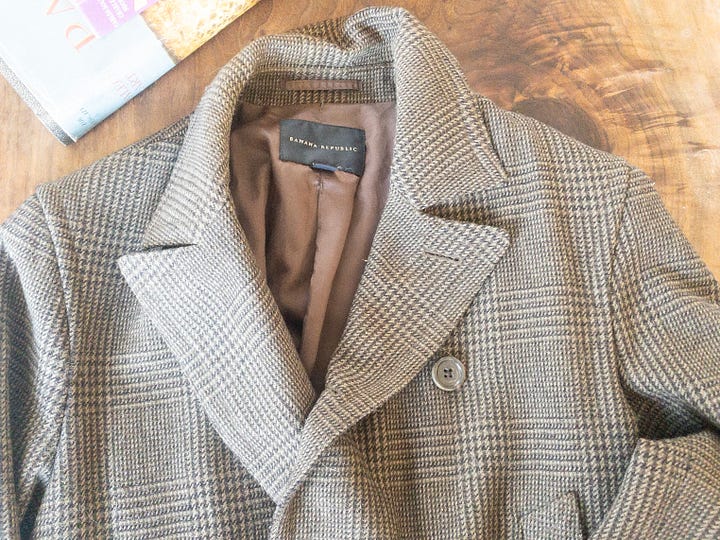
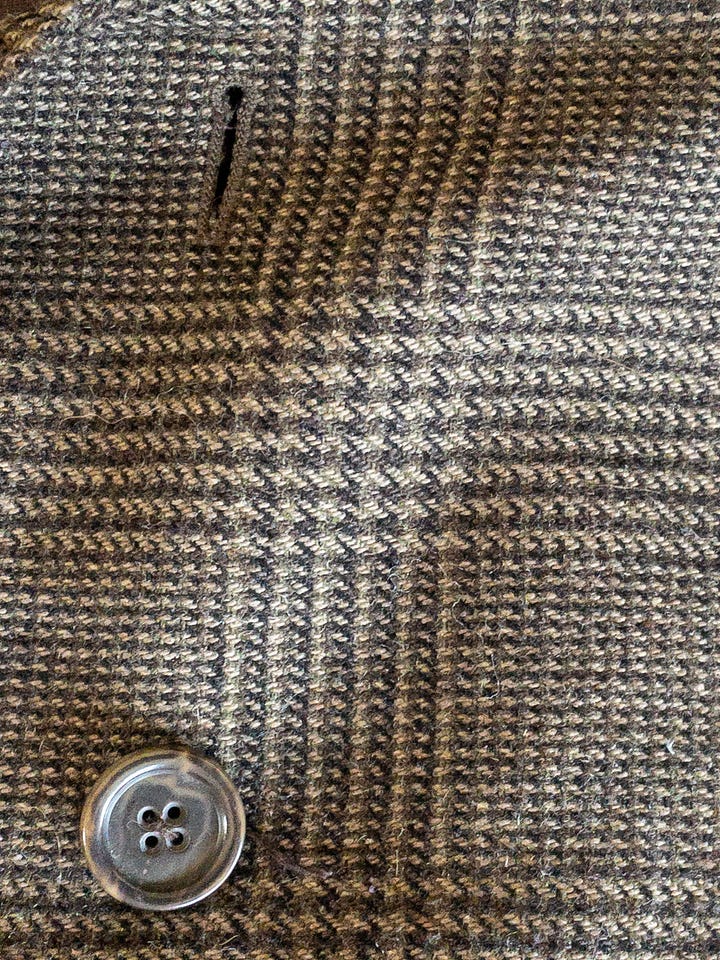
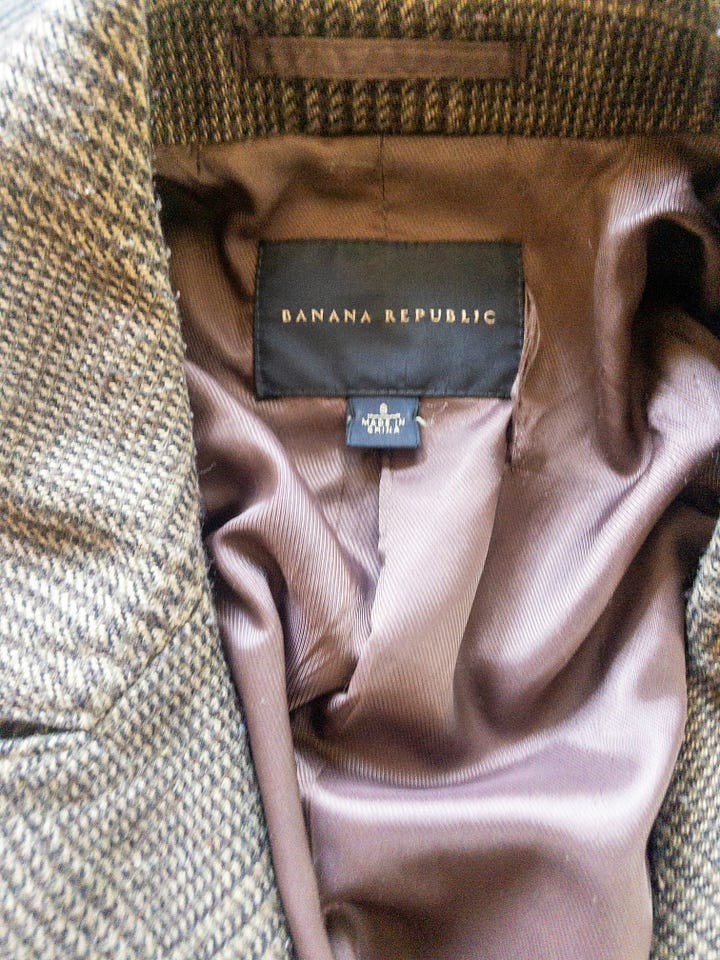
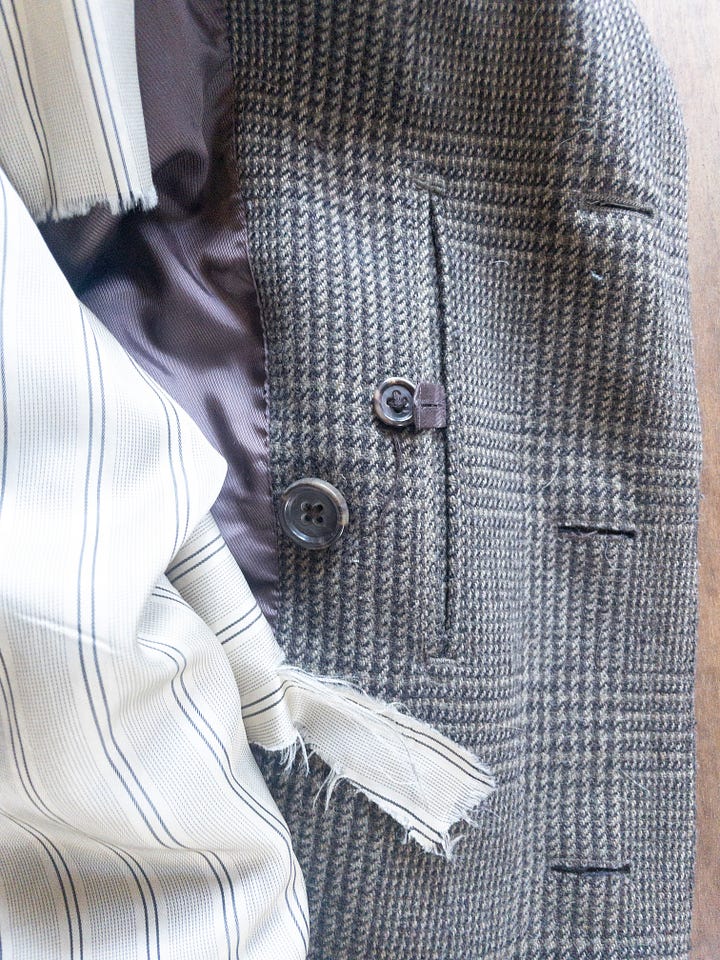
The Sentimental Factor
The Banana Republic peacoat stays around for a more important reason: sentimentality. This jacket was not just my gateway drug into good outerwear, it was a traveling companion I took into the wider world and it has come to represent a special time in my life. Somewhat improbably, it was also the jacket I took with me on a trip to London, Bruges and Brussels with Jess in the winter of 2015. She would often go to London for work in December and it was always fun to tag along and try to put another destination on the itinerary (and on this particular trip I planned one of those dreadful surprise proposals with a photographer; people used to do this sort of thing before social media ate the world and in retrospect I simultaneously apologize to my lovely wife and also regret nothing).
But this is about outerwear. As I mentioned above, this jacket is a size ‘small’ (this can be another troubling indicator in ready to wear items, as that’s not necessarily how a tailored jacket like this should be sized). By 2015 the peacoat wasn’t really in a size I would buy or wear any longer (we were well into ‘large’ at that time—the 38R sport coats having been replaced with 41R, which in turn have been further replaced by 42R today). So what is this anachronistic size doing coming along on a trip where I planned to propose marriage?
What changed between 2007 and 2015? The answer is Thom Browne. If you are dressing in menswear and have ever worn trousers that show bare ankles/have a sockless look, you’re standing on Browne’s shoulders. His shrunken fit suits for men were a life preserver tossed to us in the mid-2000s to rescue us from the oceanic tailoring proportions of the 90s (the Armani look run amok), but then ultimately ushered in the world of comedically tight fits in tailoring. This was good for everyone initially in the sense that it (i) celebrated/objectified the male physique, establishing at least a loose parity with women’s fashion in that regard; and (ii) made a convincing argument for the proper role of tailoring/fitted garments (allowing for the return of more diverse silhouettes). Like any trend, it became bad as it moved downstream over the years (with the hemlines of jackets creeping ever higher, reaching its apogee in Tom Ford’s suits for Daniel Craig’s James Bond, and its simultaneous nadir as adopted by mass market ready to wear companies like Bonobos, J. Crew and Suitsupply).6
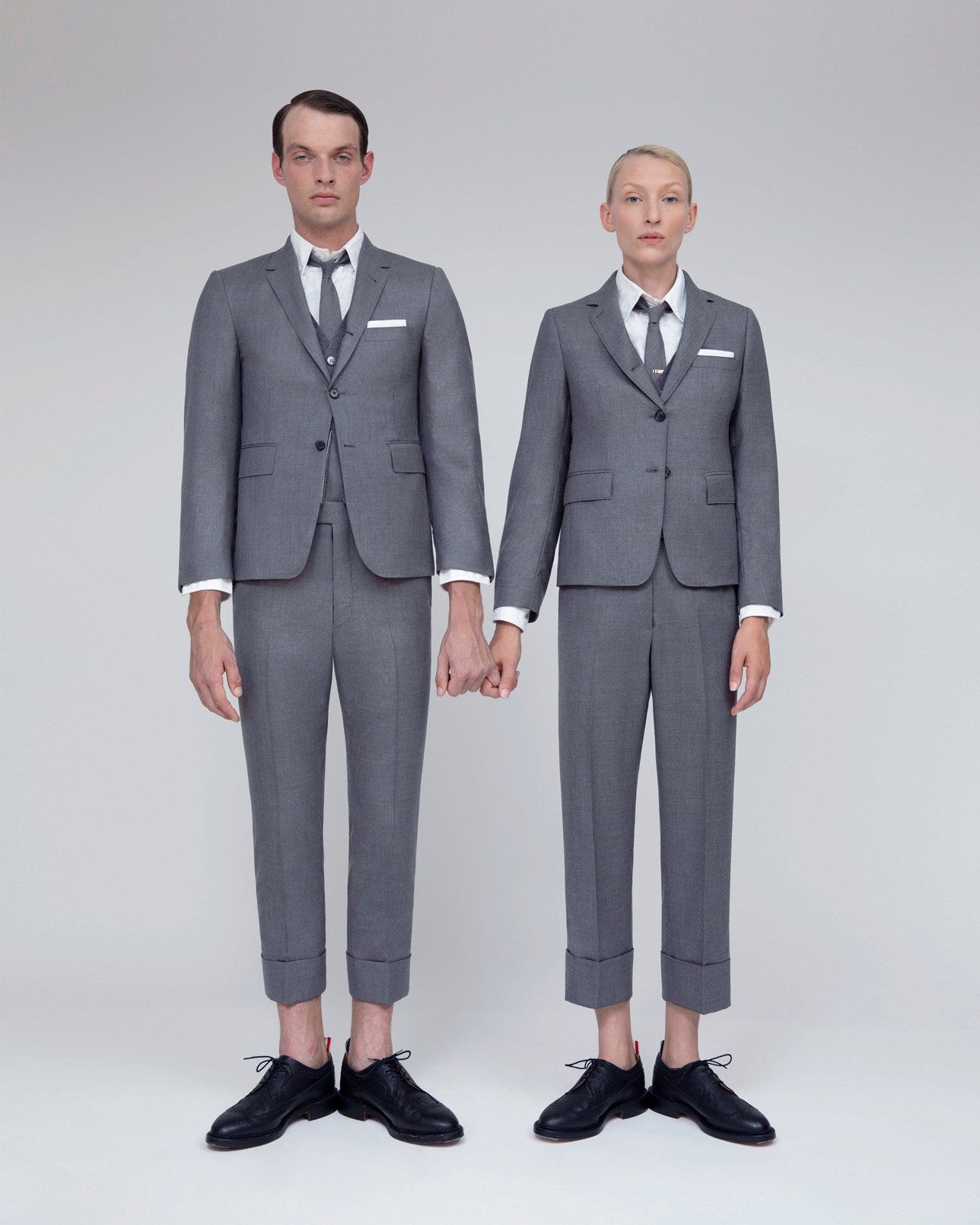
Now the pendulum has swung around again and we are favoring excess fabric. Floor length greatcoats and fuller cut trousers are in vogue now (for the latter, see Todd Snyder Spring 2024 linked below), but in the mid tens, even the length of outerwear was shrinking with the times. A prime example of this comes to us once more from Daniel Craig’s James Bond era: the Billy Reid Bond Peacoat, which is a double breasted coat with a hemline that hits mid thigh. As it happens, my Tom Ford peacoat is cut in a very similar length/proportions (which means I’ve been wearing it less as full length outerwear enjoys its comeback, but I’ve been in this game long enough to know I should just hold onto it for the inevitable return swing of the pendulum).
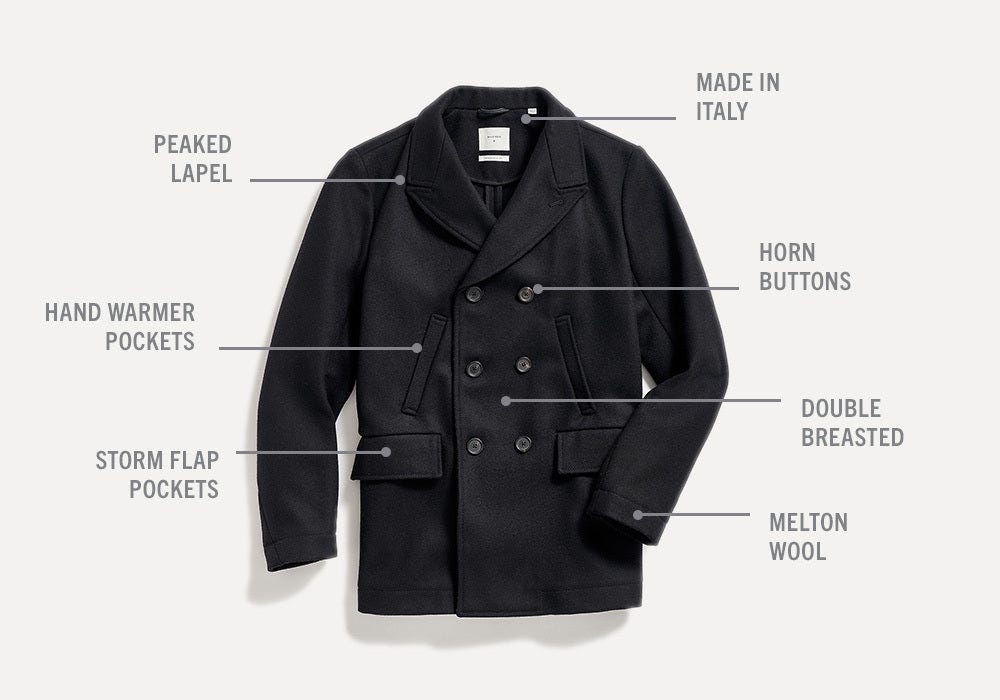
The Thom Browne—>Tom Ford—>Daniel Craig continuum is the only thing I can think of in terms of explaining how/why I was wearing this peacoat in 2015 long after it had stopped being my size. I’ve reluctantly included one photo from our trip in 2015 below to help illuminate the discourse (Jess is wearing a sequined penguin sweater under her outerwear as she was under the impression we were going to take a photo for her family’s holiday card; the penguin sweater is also a family heirloom). The fit of the jacket in these photos strikes me as merely okay today, but I love that this jacket was the one that ended up in these photos (a happy accident representing an end point to one stage of self-realization).

Looking at the peacoat itself today, I can also find some faults with it (where/how it was made, the proportions of the lapels and…that’s the end of the list actually; it’s still a great coat). Today, I really don’t have any business wearing this coat any more, unless I’m going for an anachronistic 70s sort of look (where the shrunken proportions start to make it look like a fuller cut sport coat). These considerations in no way diminish what this coat meant to me, and the various ways in which it changed my life.
I know there’s also a competing viewpoint out there. All this talk about clothes is artifice in service of nothing (or vanity or shallow aesthetic values). This counterargument is that clothes don’t make you a different or better person. I would ask a skeptic to consider the internal aspects of dressing the self and how it can fuel self-realization: who might you become with the right gateway article?

Internet Bycatch
Wherein I attempt to make good on my promise to repackage/re-contextualize some chanced upon items from the internet’s endless sea.
Pitchfork is picking albums that were critically acclaimed and scoring them with the benefit of hindsight. Here’s a perfect 10 for Brian Eno’s Ambient 1: Music for Airports (which was coincidentally selected as my welcome music for the Sublime Prosaic Symposium). I’m all for Pitchfork lending their perspective to historic/important albums, but giving it a score feels strange and unnecessary. History gave it a 10 already, just tell us what you think about it.
Nice piece of Antarctic exploration history out this week from NYT (with the sudden appearance of Explorer’s Club Flag No. 98 for auction, a flag from Byrd’s expeditions otherwise thought lost).
Bijan! Clothing for Men! The billboard at Santa Monica and Sepulveda for this legendary LA menswear store has always been a delightful piece of local color (one of my first jobs out of law school was in an office tower across the street from this billboard and the punctuation [!] always gave me a little jolt of encouragement as I waited to turn into the parking garage—the Mobil gas station below this billboard also has excellent breakfast burritos). The store unfortunately jumped into the national consciousness when it was revealed Paul Manafort liked to shop there. Anyway, it seems they are going to try out a subscription clothing service, for people with largesse exceeding sense, although I’m sure the clothes are very good.
From the US DOJ, here’s a nice breakdown of Manafort’s wardrobe, some of which was Bijan (to be fair, the Bijan stuff was mostly nicer/higher end suits and sport coats that most people could wear, with the tacky/head scratching stuff like a python jacket coming from something called Alan Couture).
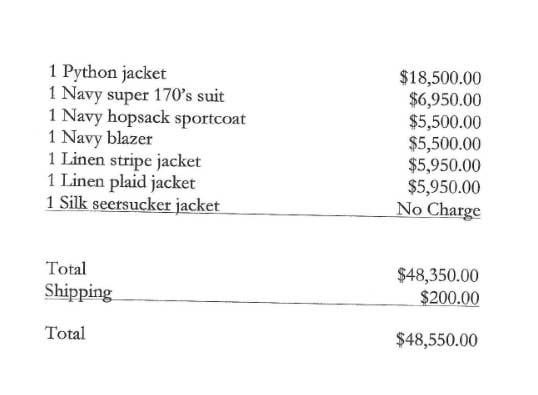
Hey Now! is a complete sentence. Clip from The Larry Sanders Show (1992).
In case you want to start thinking about Spring/Summer dressing, here’s Todd Snyder 2024—as in years past, there will be beige and I’m here for it. His fall campaign is out now as well, but only sadists look at fall clothing in the dead middle of January.
Salt Water New England coming to us with some essential information. The monograms in the LL Bean flagship store are allegedly better/different (i.e., bigger/bolder) than the ones you can get online.
My Blancpain Fifty Fathoms Bathyscaphe is still out for service. I’m told it will be back to me by April. Good timing in terms of pool activities, but the 6 months for service really tests my one watch philosophy (nothing terrible if it means living in an Apple Watch-only world for a few months every couple of years, but I feel watchless at present). For now, here’s a blog post looking at a vintage Bathyscaphe model being refurbished/serviced.
Speaking of Tom Ford, here’s a nice video reminder that he never missed. His work for Gucci in 1995 (nearly 30 years ago!) looks just as good today.
Things I Didn’t Buy
A new feature. Sometimes it’s more interesting to examine what you didn’t buy.
Orlebar Brown has these sort of Baroque Italian print shirts that I’ve had my eye on for a bit. They are finally on sale, but I’m abstaining. They could be a trap for the unwary. They have extreme niche utility (daytime discotheque chic, although it could yield interesting results at night as well) and seem to set one up for follow on purchases or even lifestyle changes (so highly suspect).
Someone please make me unaware of The Cary Collection. A coral sport coat from Grenwich, CT-based Outdoor Traders in size 42 with scrimshaw buttons? There’s wisdom in letting this one marinate for a bit as it’s high risk/high reward. I’ve wanted a coral hopsack blazer for years (I saw one executed flawlessly at a wedding in the Santa Monica canyons once), but I don’t know if I want it to have this much East Coast grammar (and coral is the sort of color you need to see in person).
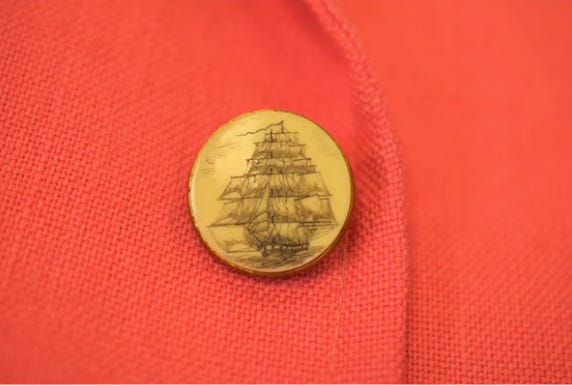
Here, I am indebted to Wessie du Toit’s Pathos of Things Substack for introducing me to the work of Deyan Sudjic and his explanation of design “archetypes,” which “offer a consoling sense of continuity. They introduce a ready-made history for an object.” Menswear, as we talk about it on Sublime Prosaic, is primarily examined through the lens of such items (pieces of apparel and accessories that carry a knowing and legible history with them). I haven’t written about any of the following items as I don’t own them, but any one of these could support the “Collection of One” treatment: the shaggy dog sweater, the anorak, the ghurka short, the banker dress shirt, the ascot, the trench coat, etc. I don’t think enough gets said about how dressing the self is aspirational in addition to expressive. You are dressing yourself with things that flatter the self (via form, fit, fabric), but in the background you are also choosing what associations you want to evoke (via function, history, design).
The nearest J. Crew was 45 minutes away (and if you were going to bother to leave town you would be much more likely to drive to Amoeba Music than another mall for critter shorts).
Banana Republic is back in a big way, as part of the whole “Revenge of the Mall Brands” thing we have going on. I am not going to bat for the quality/make, especially at their price point, but look-wise I’d say they have dialed things in nicely.
This is one of those patterns that gets its own Wikipedia page. I hope this jacket actually is glen plaid—if you write about clothes on the internet you live in fear of pedantry. Funnily enough, Ronald Reagan was also considered unpresidential for wearing a glen plaid suit in 1982, long before philistines tilted at the windmill of Barrack Obama’s tan suit.
Credit to David Coggins for first flagging this phenomenon. If the jacket requires very specific circumstances for it to be worn, it’s not really in your wardrobe at all and you may as well concede you’re holding onto it for some other reason (e.g., sentimental or archival reasons, and then the only limit is your storage space or sanity).

